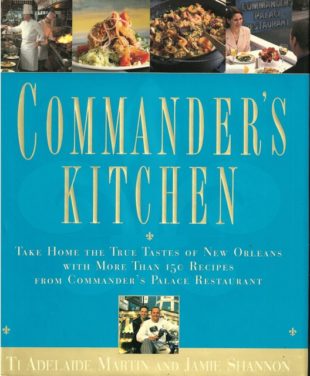Commander’s Kitchen – Introduction
First, we need to tell you something about the Commander’s Palace restaurant before delving into the book.
Commander’s Palace is a restaurant that made us change our mind about Creole food in New Orleans. This restaurant is very special. It is large, it is expensive, it is the restaurant of choice of the rich and famous, but despite this, it actually serves really good food!
It is a testimony to all involved in the running of Commanders Palace that they have not given in to the temptation to serve mediocre food in magnificent surroundings. On the contrary, despite the massive size of the restaurant, each dish appears to be prepared with skill and attention to detail that puts smaller restaurants to shame.
Many of the Creole restaurants in New Orleans are trapped by their own success, serving up the same recipes people enjoyed in the 1930s, whereas tastes and dietary choices have moved on. Commanders Palace, on the other hand, manages to serve many of the traditional favourites while seamlessly providing modern choices to diners seeking an alternative.
Whether you go here for breakfast or brunch or lunch or dinner you will be greeted with warmth (as though they are pleased that you have selected their restaurant) and civility. You will then begin the grand march through the lower floor dining room, then perhaps upstairs to one of the many smaller rooms or the large glass enclosed room out the back.
While striving for the cutting edge with the food, they haven’t by any means abandoned tradition. Gentlemen must wear a jacket (and mustn’t take it off during the evening). The waiters are also dinner-suited for the occasion.
While you peruse the long and interesting wine list a bowl of somewhat strange garlic and cheese toast will be delivered to your table.
When you get to the menu you see why people flock here. Despite being a grand restaurant by anyone’s standards, the management here certainly deliver food at very reasonable prices. At dinner, there is a deal where you can have an appetizer, entrée (main course) and dessert from a restricted menu for the price of the main course. This varies from the low to high $30 range, and hence represents excellent value.
You might start with the famous turtle soup (don’t panic they are farmed specially) or a stunning ragout of wild mushrooms in a light truffle-scented broth. Here are two extremes of the old and the new.
For main course, don’t miss the gulf fish sitting on a perfect stew of red and white beans in a delicate garlic broth-like sauce.
If you only get to go here once, then you must try the bread pudding soufflé. Order it at the start of the meal because it is cooked to order. It comes to the table raised high above the bowl; the waiter presents it with a flourish and then, almost with passion, thrusts spoonfuls of whiskey sauce into the centre of the dessert. Light, airy and full of flavour this is a great way to end the meal. We have tried it twice and it has been stunning both times.
Our many trips to New Orleans have been rewarding in that we have reached a deeper understanding of the Creole and Cajun food cultures and we have been able to determine which restaurants cater mainly for tourists and which ones are trying hard to maintain exacting standards and to showcase the best of the local recipes.
Such a place is Commander’s Palace. This is a restaurant run by a branch of the ubiquitous Brennan family that dominates the New Orleans dining scene. We expected it to be good but nothing exciting. What we experienced was precisely the opposite.
There is a real energy in this large establishment. There needs to be if they are going to turn out such high quality food for the number of people they serve day in and day out.
And it isn’t just a rehash of the standard Creole fare. This is thoughtful food with deep roots in Creole cooking mythology, yet modernised and refined for modern tastes.
So, on one of our trips to this southern city we bought the cookbook called Commander’s Kitchen. We didn’t buy it to go home and try the recipes. Rather, we wanted to understand why this restaurant is just so much better than all the other Creole restaurants in New Orleans. We also wanted to know how they had managed to modernise without destroying the links to the past.
Commander’s Kitchen is a book that should be read by all restaurateurs to find out why they get it right here most of the time. Statements in the book such as ‘strive for the absence of negatives’ and ‘doing the boring bits right every day’ show that they know that running a first class restaurant is as much about perspiration as inspiration.
Also the any little things that they do add up to an experience where mistakes are less likely to happen. Next time you go here watch as they take your first drinks order. The waitperson will deftly rearrange the salt and pepper containers – thus giving a signal to other waiting staff that the orders have been taken.
A quote in Commander’s Kitchen from Dick Brennan also rings true when he describes running a restaurant as being partly a fanatical commitment to the consistent execution of the fundamentals. By this he means dicing the vegetables, preparing the stocks from scratch, making sure that the frying oil is clean and all the other myriad things that help get things right.
So Commander’s Kitchen has it all. From the early days when gentlemen took ‘ladies’ to the restaurant through a side door and ate in curtained booths to the time when the family decided to paint the building a bright aqua despite the wisdom to the contrary, to the recent past when former chef Jamie Shannon provided inspiration in the kitchen, the full story is told.
[Note: Jamie Shannon sadly died not long after this book was published.]
Supporting the story are the recipes in Commander’s Kitchen which probably don’t translate too well outside Louisiana, but may provide some inspiration for adaptations. We tried the turtle soup at the restaurant and loved it. We think that the recipe would be adaptable to beef or veal or even game such as pheasant. Don’t be put off by the old-fashioned use of a roux as a base. Everyone uses a roux in New Orleans. Provided it is cooked through and provided there is plenty of flavour in the ingredients it isn’t necessarily a problem.
Another recipe that can easily be adapted is the lovely crab and corn Johnny Cakes with caviar. These are delightful small morsels along the lines of smoked salmon and blinis with caviar.
Two other parts to the structure of Commander’s Kitchen add interest. Every few pages there is a page entitled Lagniappe. This is one of those delightful local terms meaning something like ‘a little extra’. Restaurants do it by sending out little extras during the meal. The local newspaper has a column with that title. The Lagniappes in this book give some deeper background or some humorous asides that add human interest to the book.
The other very useful addition is the Chef Jamie’s Tips. Here, Jamie Shannon gives very practical and very detailed hints for cooking.
Overall we found this to be a beautifully produced book with something of interest on every page.
We have chosen this book to be an entry in our Foodtourist Top Fifty Cookbooks list.
You can by Commander’s Kitchen clicking on the link below:






















